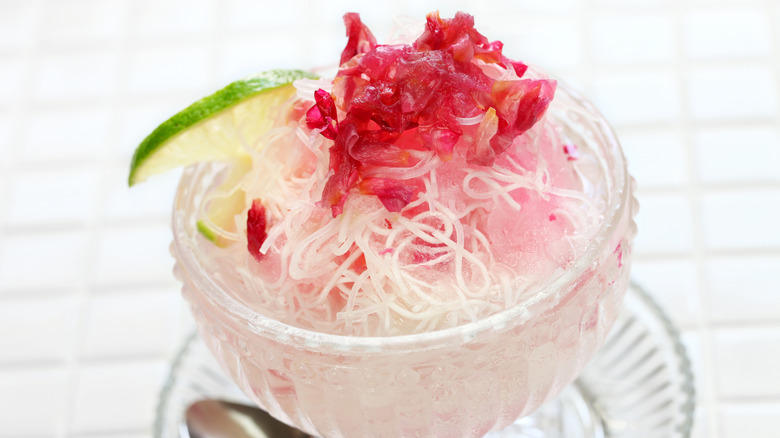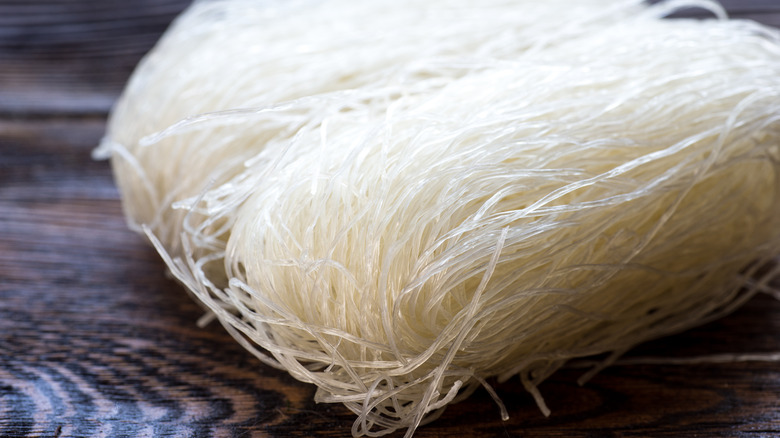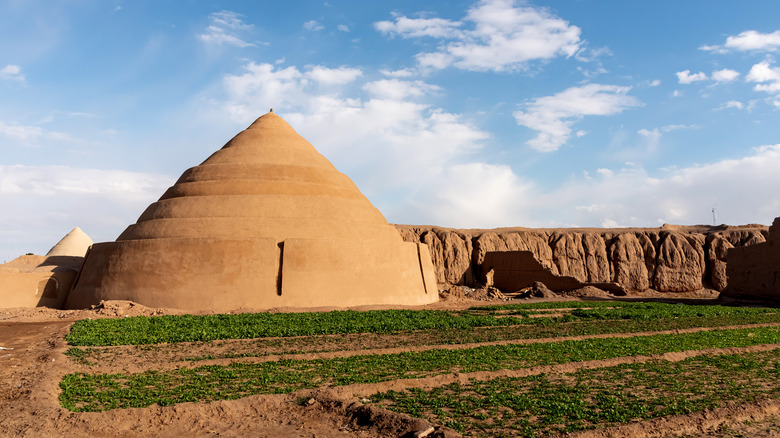Fāloodeh: The Delectable Persian Frozen Dessert For Noodle Lovers
It's hardly an overstatement to say that Persian food is the mother of many cuisines. Starting in the sixth century B.C., cooks in what is now modern-day Iran created textures and flavor combinations that provided the foundation for, or at least deeply influenced, cuisines from India to Italy and North Africa to Turkey. The cuisine has persisted through the millennia despite successive Greek, Muslim, and Mongol conquests. Tender breads, bowls of mild white rice redolent with saffron, savory meat dishes enriched with dried fruit and nuts, and even a form of dried buttermilk called kashk — this is all in the purview of Persian cuisine. In fact, it's the Persians, not the Italians, who invented sorbet, and a lime-infused, rose-scented version of this ancient dessert persists to this day, known as fāloodeh, which has the added delight of tender noodles.
These aren't Italian-style noodles like spaghetti, made from durum wheat flour (although even early pasta dishes tended to be sweet). Instead, fāloodeh uses noodles like vermicelli or cellophane (sometimes known as glass) noodles; alternatively, they can be made from wheat starch. Cooked to absorbent, chewy perfection, they're bathed in a sugar and rosewater syrup, chilled until half-frozen, doused with fresh lime juice and sour cherry syrup, and often served with garnishments like chopped pistachios, fresh berries, and mint.
Using your noodle(s)
Most fāloodeh ingredients — sugar, rosewater (which you might already have around for making rosewater almond shortbread), fresh limes, sour cherry syrup — are uncomplicated and easily obtained. That leaves the noodle part of the dish as really the only problem to solve. Luckily, there are almost no wrong answers. You can run a hot slurry made from wheat and water through a specialized noodle extruder into an ice bath, or you could just buy something premade and delicious. But what are the best options?
Anything starchy and delicate will work; look for noodles about the size of angel hair pasta. We mentioned cellophane noodles, which can be made from mung bean starch or sweet potato starch, among other things. These will provide a visually transparent, absorbent, and slightly chewy feature, which is perfect for the dish. In addition, the Vietnamese noodle known as bún (also called rice vermicelli or rice stick) will do wonderfully well in fāloodeh.
A delicious history of ice-cold desserts
The origins of fāloodeh are obscured by history. Some say the dessert dates as far back as 400 B.C. Legend has it that it was invented by accident, when someone spilled a flavored syrup on the snow. (This apparently apocryphal story actually has a ring of truth to it: there is a written Persian account dating from the sixth century A.D. in which a prospective valet of the Sassanid royal court declares his favorite dessert to be "snow with fruit syrup.")
What we do know is that the Persians took their cold foods and drinks seriously, building beehive-shaped ice pits called yakhchals to keep them refrigerated or partially frozen. Some of these structures were constructed of local adobe mixed with materials like animal hair and egg whites as binding agents. Ice harvested from nearby canal-fed ice-making ponds in the mountainous areas would be brought into the yakhchals, which would likely have been covered on the outside with straw to act as insulation. This might seem like a lot of effort to go through just for a refreshing frozen dessert, but on second thought, it doesn't at all.


